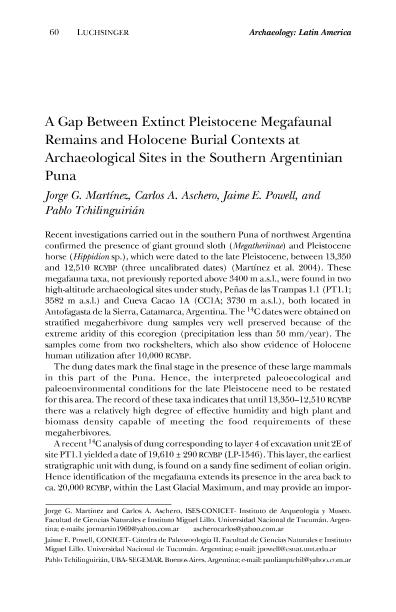Artículo
A Gap Between Extinct Pleistocene Megafaunal Remains and Holocene Burial Contexts at Archaeological Sites in the Southern Argentinian Puna
Fecha de publicación:
12/2007
Editorial:
Center for the Study of the First Americans
Revista:
Current research in the pleistocene
ISSN:
8755-898X
Idioma:
Inglés
Tipo de recurso:
Artículo publicado
Clasificación temática:
Resumen
Recent investigations carried out in the southern Puna of northwest Argentina confirmed the presence of giant ground sloth (Megatheriinae) and Pleistocene horse (Hippidion sp.), which were dated to the late Pleistocene, between 13,350 and 12,510 RCYBP (three uncalibrated dates) (Martínez et al. 2004). These megafauna taxa, not previously reported above 3400 m a.s.l., were found in two high-altitude archaeological sites under study, Peñas de las Trampas 1.1 (PT1.1; 3582 m a.s.l.) and Cueva Cacao 1A (CC1A; 3730 m a.s.l.), both located in Antofagasta de la Sierra, Catamarca, Argentina. The 14C dates were obtained on stratified megaherbivore dung samples very well preserved because of the extreme aridity of this ecoregion (precipitation less than 50 mm/year). The samples come from two rockshelters, which also show evidence of Holocene human utilization after 10,000 RCYBP. The dung dates mark the final stage in the presence of these large mammals in this part of the Puna. Hence, the interpreted paleoecological and paleoenvironmental conditions for the late Pleistocene need to be restated for this area. The record of these taxa indicates that until 13,350–12,510 RCYBP there was a relatively high degree of effective humidity and high plant and biomass density capable of meeting the food requirements of these megaherbivores. A recent 14C analysis of dung corresponding to layer 4 of excavation unit 2E of site PT1.1 yielded a date of 19,610 ± 290 RCYBP (LP-1546). This layer, the earliest stratigraphic unit with dung, is found on a sandy fine sediment of eolian origin. Hence identification of the megafauna extends its presence in the area back to ca. 20,000 RCYBP, within the Last Glacial Maximum, and may provide an imporant beginning date for deglaciation at this elevation, which is according to paleoclimatic models designed for the Andean tropical zone (Paduano et al. 2003). In the study area, High-andean steppe is now found at 4200–4800 m a.s.l., but under these conditions, plant biomass likely increased locally with reference to dominant conditions of the glacial maximum
Palabras clave:
Contexto arqueológico
,
Pleistoceno, Holoceno
,
Puna Argentina
Archivos asociados
Licencia
Identificadores
Colecciones
Articulos(ISES)
Articulos de INST.SUPERIOR DE ESTUDIOS SOCIALES
Articulos de INST.SUPERIOR DE ESTUDIOS SOCIALES
Citación
Martinez, Jorge Gabriel; Aschero, Carlos Alberto; Powell, Jaimie E.; Tchilinguirian, Pablo; A Gap Between Extinct Pleistocene Megafaunal Remains and Holocene Burial Contexts at Archaeological Sites in the Southern Argentinian Puna; Center for the Study of the First Americans; Current research in the pleistocene; 24; 12-2007; 60-62
Compartir




